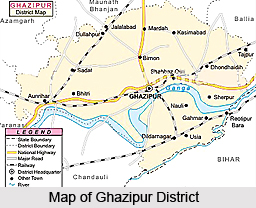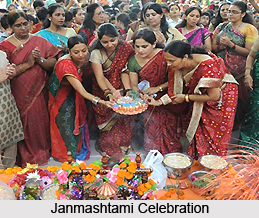 Ghazipur District forms the eastern part of the Varanasi Division in Uttar Pradesh. Ghazipur is the district headquarters. It lies to the east and north of Jaunpur and Varanasi district respectively. Ghazipur District is situated between the parallels of 25 degree 19 minutes and 25 degree 54 minutes north latitude and 83 degree 4 minutes and 83 degree 58 minutes east longitude. This location is around 67.50 metres above the sea level. The length of district from east to west is 90 kms and width from north to south is 64 kms. Ganga River from one side and Karamnasa River from other side divide it from Bihar. It is bounded by Ballia District and Bihar in the east, Jaunpur, Varanasi and Azamgarh in west, Mau in north and Chandauli District in the south. The boundaries are generally conventional though at places they are marked by natural features. The common language used by the people is Bhojpuri language.
Ghazipur District forms the eastern part of the Varanasi Division in Uttar Pradesh. Ghazipur is the district headquarters. It lies to the east and north of Jaunpur and Varanasi district respectively. Ghazipur District is situated between the parallels of 25 degree 19 minutes and 25 degree 54 minutes north latitude and 83 degree 4 minutes and 83 degree 58 minutes east longitude. This location is around 67.50 metres above the sea level. The length of district from east to west is 90 kms and width from north to south is 64 kms. Ganga River from one side and Karamnasa River from other side divide it from Bihar. It is bounded by Ballia District and Bihar in the east, Jaunpur, Varanasi and Azamgarh in west, Mau in north and Chandauli District in the south. The boundaries are generally conventional though at places they are marked by natural features. The common language used by the people is Bhojpuri language.
History of Ghazipur District
Ghazipur District was constituted a separate district in 1818. Originally the district was very big, including not only modern Ballia but also Narwan of Varanasi, Chausa of Buxar (Bihar) and Pargana of Sagari, Ghosi, Mau and Muhammadabad in Azamgarh District. Early history of Ghazipur District dates back to Vedic and Ramayana era. It states that this region was covered with dense forests and many Ashrams were situated here. It was an important centre of Lord Buddha`s preaching.
Geography of Ghazipur District
Ghazipur District is garlanded by Ganga, Karamnasa and Gomti, that makes this region stronger in economic and geographic condition. The total geographic area of this district is 3384 sq kms. Ghazipur is embellished with picturesque geographical environs. Geography of Ghazipur District is a part of mid Gangetic plains. Total area is approximately 3, 33,209 Hectares in which 2, 52,824 Hectare is for agriculture purpose. Approximately 38 percent of soil is cattle field. This district does not contain any forest area.
Administration of Ghazipur District
 Administration of Ghazipur District has five sub-divisions namely Sadar, Saidpur, Zamania, Muhammadabad and Jakhania each also forming a tehsil of same name. Tehsil Saidpur constitutes the western sub-division of the district. Tehsil and sub-division Ghazipur constitutes the central part, tehsil Muhammadabad forms the north eastern subdivision and extends eastward from the border of Ghazipur to boundary of Ballia. Tehsil Zamania forms the south western subdivision, Jahkhnia sub-division, a newly constructed tehsil located in north western part of the district. Ghazipur District consists of 16 Development Blocks, 193 Panchayats and 1046 Gram Sabhas. It also includes a total 2583 inhabited villages and 781 uninhabited villages. In Urban sector there are 3 Nagar Paika Parishad (Ghazipur, Muhammadabad, and Zamania) and five towns (Saidpur, Jangipur, Dildarnagar, Sadaat and Bahadurganj). There are 23 Police Stations in Ghazipur District.
Administration of Ghazipur District has five sub-divisions namely Sadar, Saidpur, Zamania, Muhammadabad and Jakhania each also forming a tehsil of same name. Tehsil Saidpur constitutes the western sub-division of the district. Tehsil and sub-division Ghazipur constitutes the central part, tehsil Muhammadabad forms the north eastern subdivision and extends eastward from the border of Ghazipur to boundary of Ballia. Tehsil Zamania forms the south western subdivision, Jahkhnia sub-division, a newly constructed tehsil located in north western part of the district. Ghazipur District consists of 16 Development Blocks, 193 Panchayats and 1046 Gram Sabhas. It also includes a total 2583 inhabited villages and 781 uninhabited villages. In Urban sector there are 3 Nagar Paika Parishad (Ghazipur, Muhammadabad, and Zamania) and five towns (Saidpur, Jangipur, Dildarnagar, Sadaat and Bahadurganj). There are 23 Police Stations in Ghazipur District.
Education in Ghazipur District
Literacy rate in Ghazipur District is around 59.55 percent, out of which male literacy rate is 74.87 percent and female literacy rate is 42.36 percent. Education level is also standard in the district. Ghazipur District has several Post Graduate College, Government Homeopathic College, Government Poly-technique College, Government Industrial Training Institute, Technical Education Research Institute, Unani Medical College and many other educational institutes.
Culture of Ghazipur District
Culture of Ghazipur District is rich and vibrant. It is composed of traditional beliefs, fairs, festivals, music and folk dances. Makar Sankranti, Janmashtami, Ramnavami, Ganesh Chaturthi, Holi, Id Ul Fitr, Muharram, Id Ul Zuha are some of the main festivals celebrated in the district. Near about 32 fairs are held in different parts of the district on various occasions.
Tourism in Ghazipur District
In Ghazipur District there are several places worth exploring. It is one of the popular tourist destinations of Uttar Pradesh. Aunrihar, Bhitari, Bahadurganj, Ghazipur, Dildarnagar, Gauspur and Zamania are some of the noteworthy places of interest in this district. These places have historical as well as religious importance.
The District has a sound agricultural base and reasonably good infrastructure but industrial potential is low.






